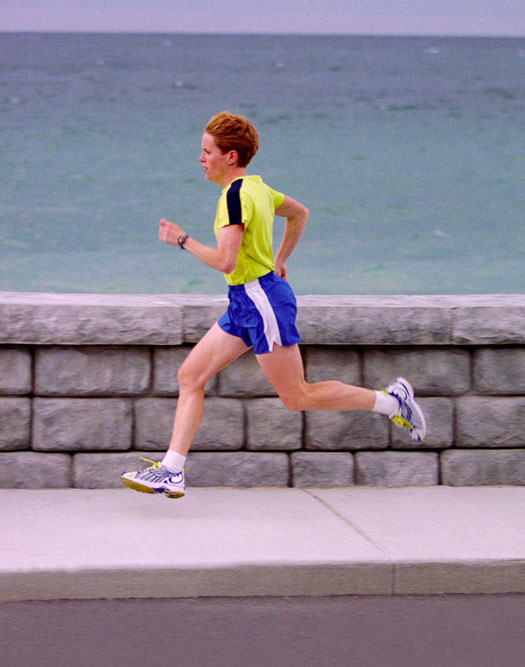Running posture is similar to the posture that your mother nagged you about when you were growing up: It's how you hold your back, shoulders, and neck. What position is your back in when you run? To find out, have a friend take a video of you (straight on and from the side). If that's not possible, ask someone to take a picture of you, from the side, as you run by. Although not as effective, you can also run in place, sideways, next to a full-length mirror and look at your posture. Either way, evaluate what you see and determine which of the following categories you fall into:
- Your back is perfectly straight up and down. Running with your back perfectly straight can make for good running posture, as long as it doesn't indicate that your body is as tight as a violin string. Be sure that, in keeping your back straight, your body isn't rigid, such that your neck and arms are tensed instead of relaxed. If running with a perfectly straight back is natural to you and you feel relaxed, don't try to change it. But if you feel tense, try to lean forward just slightly from your waist as you run.
- You lean just slightly forward from your waist. This is the most common — and most efficient — way to run, with a slight lean forward. With just a slight lean, your arms, back, neck, shoulders, and diaphragm relax. See Figure 1.
>

Figure 1: Correct running posture inclines an ever-so-slight forward lean.
- You lean far forward at the waist. Although this posture is unusual, some runners do lean so far forward that they look as though they may fall. This posture puts quite a bit of pressure on your lower back and doesn't allow you to keep your eyes up and on the back of the person ahead of you in your marathon. It can also interfere with your breathing. Although changing your posture may seem awkward at first, try pulling yourself back to perfectly straight or a slight lean forward for at least three runs.
- You lean back at your waist. Leaning too far back makes you unable to fully fill your diaphragm, which means that you can't breathe as well as you would if you leaned a bit forward. Instead, you want to lean forward slightly at the waist. Also think about bringing your chin down, because it's likely tipped back.
- The main reason people run with a slight lean back is because they're fatigued in their arms and upper body. If you begin to lean back at the end of workouts or races, consider adding pushups or an entire circuit routine to your training.
When running uphill, lean forward, so that you're leaning into the angle of the hill. Thrust your elbows back hard as you run up the hill. In this position, you run hills powerfully, instead of letting hills conquer you.
Two other common mistakes in running posture are as follows:
- Scrunching your shoulders so that they're up near your ears. This makes running far more difficult than it needs to be. Instead, relax your shoulders and hold them slightly back — just like your teacher told you to stand when you were a kid. Efficient running is all about relaxation, and you can't relax your body with your shoulders all scrunched.
- Tilting your chin up so that it points to the sky. Ideally, your neck stays perfectly straight; your chin is neither tilted down toward your chest nor tilted up. Many runners, however, do tilt their chins up, especially as they become fatigued. Practice keeping your neck perfectly straight as you run.
>
dummies
Source:http://www.dummies.com/how-to/content/sizing-up-your-running-posture.html
No comments:
Post a Comment